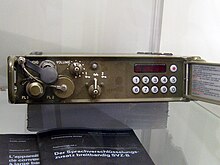Secure voice
The examples and perspective in this article deal primarily with the United States and do not represent a worldwide view of the subject. (February 2018) |


Secure voice (alternatively secure speech or ciphony) is a term in
.History
The implementation of voice encryption dates back to
From the introduction of voice encryption to today, encryption techniques have evolved drastically. Digital technology has effectively replaced old analog methods of voice encryption and by using complex algorithms, voice encryption has become much more secure and efficient. One relatively modern voice encryption method is
Digital
A digital secure voice usually includes two components, a
This has led to the use of Voice Coders (
Secure voice's robustness greatly benefits from having the voice data compressed into very low bit-rates by special component called
Digital methods using voice compression: MELP or MELPe
The
The initial MELP was invented by Alan McCree around 1995.
Between 1998 and 2001, a new MELP-based vocoder was created at half the rate (i.e. 1200 bit/s) and substantial enhancements were added to the MIL-STD-3005 by SignalCom (later acquired by Microsoft), AT&T Corporation, and Compandent which included (a) additional new vocoder at half the rate (i.e. 1200 bit/s), (b) substantially improved encoding (analysis), (c) substantially improved decoding (synthesis), (d) Noise-Preprocessing for removing background noise, (e) transcoding between the 2400 bit/s and 1200 bit/s bitstreams, and (f) new postfilter. This fairly significant development was aimed to create a new coder at half the rate and have it interoperable with the old MELP standard. This enhanced-MELP (also known as MELPe) was adopted as the new MIL-STD-3005 in 2001 in form of annexes and supplements made to the original MIL-STD-3005, enabling the same quality as the old 2400 bit/s MELP's at half the rate. One of the greatest advantages of the new 2400 bit/s MELPe is that it shares the same bit format as MELP, and hence can interoperate with legacy MELP systems, but would deliver better quality at both ends. MELPe provides much better quality than all older military standards, especially in noisy environments such as battlefield and vehicles and aircraft.
In 2002, following extensive competition and testing, the 2400 and 1200 bit/s US DoD MELPe was adopted also as
The
In 2005, a new 600 bit/s rate MELPe variation by Thales Group (France) was added (without extensive competition and testing as performed for the 2400/1200 bit/s MELPe) [6] to the NATO standard STANAG-4591, and there are more advanced efforts to lower the bitrates to 300 bit/s and even 150 bit/s.[7]
In 2010 Lincoln Labs., Compandent, BBN, and General Dynamics also developed for DARPA a 300 bit/s MELP device .[8] Its quality was better than the 600 bit/s MELPe, but its delay was longer.
See also
- Scrambler
- MELPe
- MELP
- Cryptography
- Pseudorandom noise
- SIGSALY
- SCIP
- Secure telephone
- Secure Terminal Equipment
- VINSON
- VoIP VPN
- NSA encryption systems
- ZRTP
- Fishbowl (secure phone)
References
- ISBN 0-333-51922-1.
- ^ Kak, S. and Jayant, N.S., Speech encryption using waveform scrambling. Bell System Technical Journal, vol. 56, pp. 781–808, May–June 1977.
- ^ A Mixed Excitation LPC Vocoder Model for Low Bit Rate Speech Coding, Alan V. McCree, Thomas P. Barnweell, 1995 in IEEE Trans. Speech and Audio Processing (Original MELP)
- ^ Analog-to-Digital Conversion of Voice by 2,400 Bit/Second Mixed Excitation Linear Prediction (MELP), US DoD (MIL_STD-3005, Original MELP)
- ^ THE 1200 AND 2400 BIT/S NATO INTEROPERABLE NARROW BAND VOICE CODER, STANAG-4591, NATO
- ^ MELPe VARIATION FOR 600 BIT/S NATO NARROW BAND VOICE CODER, STANAG-4591, NATO
- ISBN 0-07-138038-8.
- ^ Alan McCree, “A scalable phonetic vocoder framework using joint predictive vector quantization of MELP parameters,” in Proc. IEEE Int. Conf. Acoust., Speech, Signal Processing, 2006, pp. I 705–708, Toulouse, France
